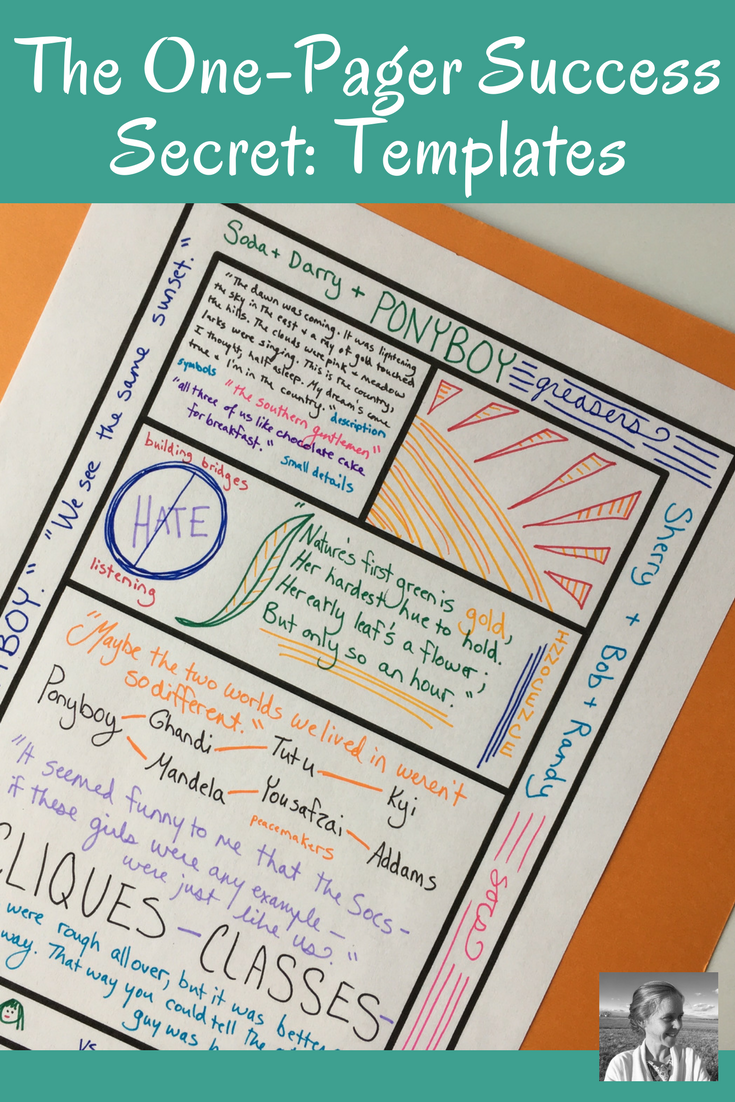A Guest Post by Betsy Potash
One-pagers are all the rage these days. When students process their learning in this fun visual style, the results are powerful.
The one-pager strategy calls for students to share what they have read/heard/learned in a single page of sketchnotes, including whatever key elements you require as a teacher (more on that later!)
You can use a one-pager in a lot of different situations.
For example:
Ask readers in your choice program to create one-pagers for their free reading books
Have students create a one-pager to help them review a full-class novel before writing papers
Use the one-pager as a creative final assessment for any reading
Ask students to create a one-pager based on a film you watch in class
Invite students to create a one-pager linking multiple texts (I learned about this option after a teacher in my Facebook group, Creative High School English, shared the amazing one-pagers her students created to link stories they had read with stories they had heard on The Moth. See the picture below!)
One-Pagers by the Students of Christy Willett (using my set of free templates you can get here)
One-pagers not only help students to think critically about what matters most from a text, they also give students a lot of creative options for how to illustrate those highlights.
Some students will LOVE flexing their creative muscles and showing their artistry. Others, not so much.
As I have talked to teachers about one-pagers this year, the main issue folks run into is that students who aren’t into art find the assignment frustrating. They are unsure of how to be successful if they aren’t into doodling and colored pencils.
Which leads us to my secret solution, templates. When you hand a student a blank page and ask them to go for it, many students who don’t self-identify as artistic will be overwhelmed and annoyed. When you hand a student a page already broken into sections, with crystal clear instructions for what should go in each, they have a roadmap to success. They can ace the assignment whether or not they’ve got an inner graphic designer.
So what might you want to ask them to include in their templated one-pagers? The sky’s the limit, but here are a few ideas to get you started.
Possible Template Elements:
A border which somehow represents key themes
An image in the upper left hand corner with a quotation woven into or around it. This image should somehow represent what the most important symbol in the text so far.
Images and/or doodled words in the upper right hand corner that represent the key characters from the text and perhaps how they are changing
Images and quotations in the lower left hand corner that show the author’s style of writing, and the power of the language that is used
Images and/or words in the bottom right hand corner that show connections between the themes and ideas in the writing and what is going on in the world today.
Three important quotations from the text
Words and/or images that show the significance of the setting in some way
When you make your expectations clear, students will quickly realize they are a lot better at creating one-pagers than they might have thought. In fact, you’ll probably be astonished at their critical thinking and creative results.
Ready to dive into one-pagers in your class? Want a free packet of four templates with full instructions for each to get you started? Sign up here!
About the Author
Betsy Potash from Spark Creativity
I love to help ELA teachers innovate. Discover creative teaching strategies on my website, listen to them in your earbuds through my podcast, or shop my TPT store for creative curriculum like the ELA Makerspace Short Story Unit and the Literary Food Truck Project. Oooh, did I mention you’re invited to join up with two thousand other creative ELA teachers in my free Facebook group, Creative High School English?






